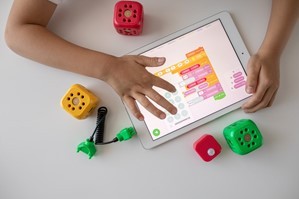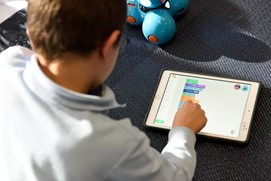Technology is Here to Stay: Utilizing Tech Tools to Promote Students’ Literacy

These days, kindergartners with missing teeth and basic reading skills can often navigate a Google Document or “Zoom Room” as well as the average adult. After an extended period of virtual education, these students are more well-versed in and reliant on digital tools, allowing them to communicate with their teachers and peers, organize assignments, and even learn the fundamentals of reading and writing. Educational technology is unlikely to disappear at any point in the near future: if anything, it will continue to evolve in response to the needs of teachers, students, and caregivers. Considering this reality, educators are wise to consider the latest research on educational technology and thoughtfully implement digital elements into their in-person classrooms to support students’ reading and overall confidence.
Almost unanimously, researchers agree that too much tech is unhealthy, particularly for our youngest and most impressionable generation. Yet in a world where tech is here to stay, educators are challenged to incorporate digital elements that will increase students’ literacy skills. Tools like text-to-speech assistive technology, audiobooks, and online phonics lessons like our own are essential for literacy education at home or in hybrid learning environments. To enhance literacy in both contexts, Dr. Megan Allen, the founder and chief learning curator at The Community Classroom, also recommends the recording function on a tablet or smartphone, which can be used for audio-journaling, peer and teacher feedback, and as a way for students to reflect on their own reading fluency. Pixar short films, writes Dr. Allen, can even be used as comprehension exercises that encourage students to make inferences and predictions, discuss story elements, think critically about character feelings, or look at cause and effect relationships. Common among these strategies is an underlying recognition of the pervasiveness of technology, coupled with an educator’s decision to turn tech on its head and creatively enhance a young student’s reading journey.

Equipped with a basic understanding of technology, younger students can become reading masters and digital whizzes with the guidance of innovative teachers. This is especially true in today’s classroom, where the pandemic has accelerated our capabilities with technology at all ages. Larry Ferlazzo, an English and social studies teacher, affirms this new reality in a recent reflection on Google Docs. The shareable online documents allow Ferlazzo to “drop into” a student group’s work during class and help make writing, comprehension, and research better than it would have been otherwise. For older students with higher-level reading comprehension and writing skills, a basic technology such as Google Docs can be transformed into a collaborative, creative, and student-powered platform.
For both new readers and older students, educators and tech creators are increasingly aware of the potential of smartphone applications to augment literacy education. One of the newest literacy apps, WordSmart, taps into the human passion for stories and our aptitude for phonics to help students develop reading skills. WordSmart takes readers on an interactive adventure with the characters Tama and Tracey and tells stories about how different letters got their sounds (for example, ‘A’ is all about apples and ants). Then, readers play games where they have to match the shape of the letters to the corresponding sounds. This “gamification” of reading engages children in both the complexity and magic of reading, and the app also offers kids ways to promote self-control or manage their emotions through breathing, tracing exercises, and other mindfulness techniques. The app’s founder and former teacher, Paul Blackman, wants to offer a digital tool that is conscious of children’s diverse educational needs and socioeconomic backgrounds, and partnered with reading scientists from the Sweden-based Karolinska Institute to assess app users’ language fluency and modify their experiences of the app based on literacy levels.
From science-based apps to old-fashioned audiobooks, technology has much to offer to young readers, their educators, and their caregivers. With our newfound appreciation for in-person education, teachers can strategically implement technology into their literacy curricula to excite students, assist their caregivers, and nurture lifelong readers in a tech-based world.
Take-Aways:
- Both students and educators have significantly improved their technology skills since the beginning of the pandemic.
- Educators can utilize students’ technological proficiency to improve their literacy skills, both in and out of the classroom.
- Teachers and parents have access to a variety of technological tools, including audiobooks, apps, and even Pixar short films, to challenge young readers and promote higher-level comprehension and writing in older students.
- Noting the array of backgrounds and abilities in a classroom, teachers are encouraged to implement digital tools and design curricula that adapt to their student's unique needs.
Start Teaching Reading for Free Now!
Access Level 1’s four interactive stories and the accompanying supplemental resources to teach elementary students how to read. No credit card is needed. Join the 42,635 teachers and students using our reading program.
